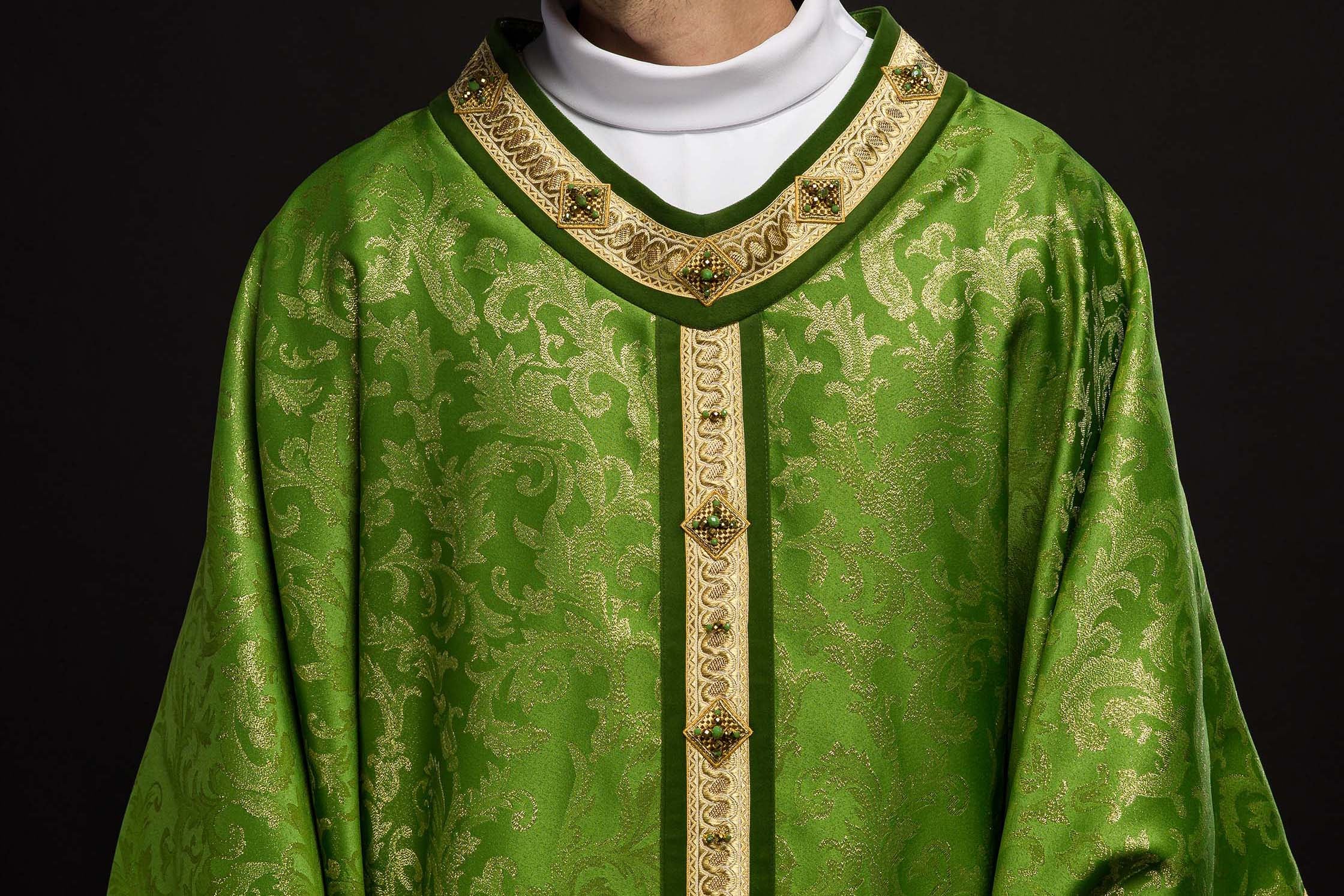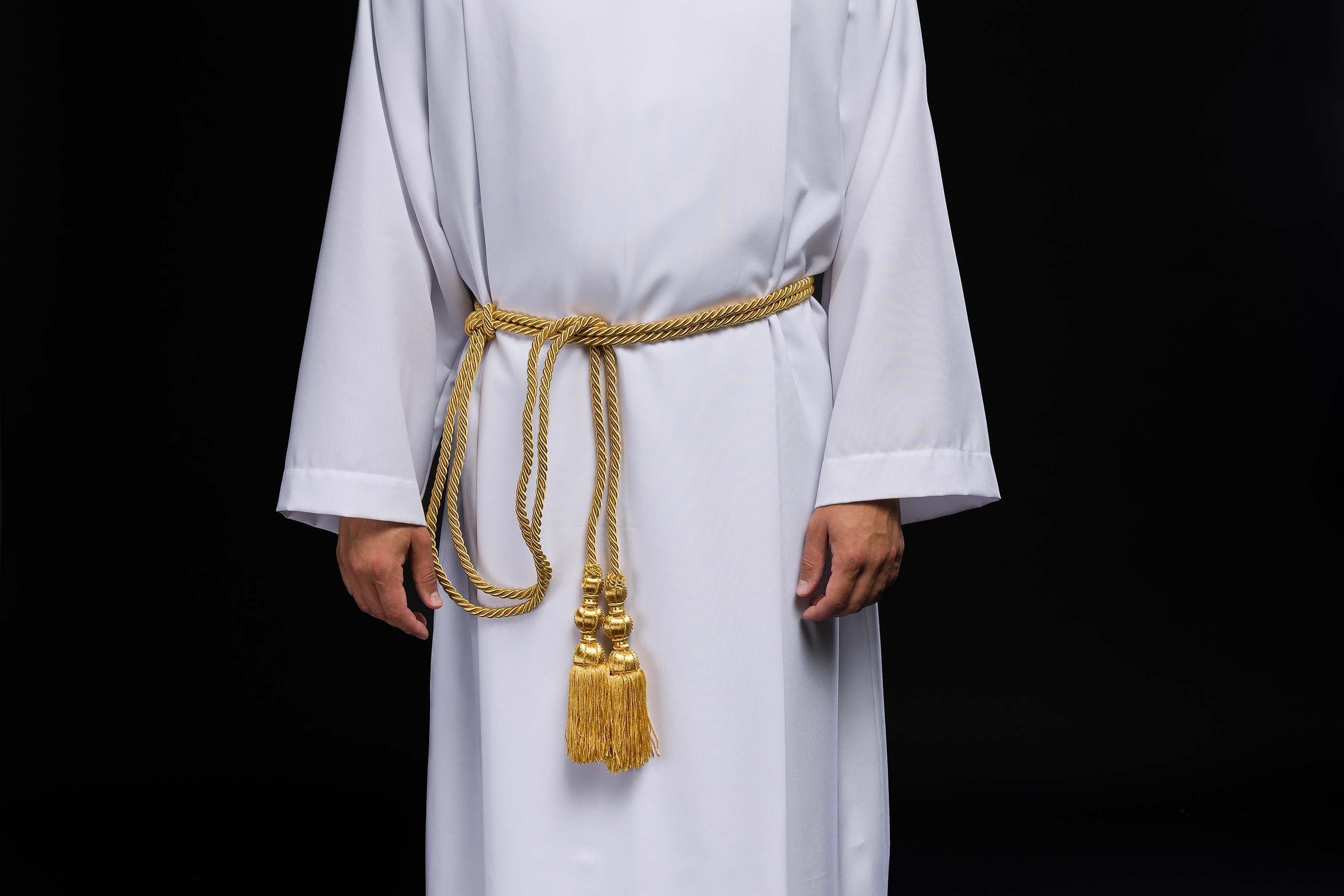
The Liturgical Year: Division and Symbolism of Seasons
Liturgical Year – Division and Symbolism of Periods
The liturgical year is the heart of the Church's spiritual life, a cycle that sets the rhythm of prayer, celebration, and reflection on the mysteries of salvation. It is a dynamic story of the life of Jesus Christ, from His incarnation, through His passion and resurrection, to the descent of the Holy Spirit and the anticipation of His second coming. Understanding the division and symbolism of each period allows for a deeper experience of faith and more active participation in the Eucharistic mysteries. HAFTINA TEXTILE GROUP, as a producer of richly decorated liturgical vestments, perfectly understands the significance of each stage of this spiritual calendar, reflecting its beauty and depth in its products.
Structure of the Liturgical Year: A Cycle of Celebrations
The liturgical year is not a fixed, linear sequence, but a cyclical renewal of the memory of Christ's saving works. Its beginning is marked by the first Sunday of Advent, and its end by the Solemnity of Christ the King of the Universe, one week before Advent. This structure focuses on two main feasts: Christmas and Easter, which mark the central points of the year.
Advent: A Time of Waiting and Hope
Advent, lasting four Sundays before Christmas, is a period of joyful anticipation of Jesus' coming. It is a time of penance, reflection, and fervent prayer, preparing hearts for the birth of the Savior. The symbolism of Advent is primarily emphasized by the color purple, signifying penance and preparation, but also hope. During this period, the liturgy often uses motifs associated with messianic prophecies, announcing the coming of Christ. Masses are celebrated in an atmosphere of focus, and Advent calendars remind us of the passage of time and the approaching joyful event. Purple vestments, often adorned with subtle embroideries symbolizing hope and expectation, are an integral part of the Advent liturgy. HAFTINA offers a rich selection of Advent vestments that help clergy and faithful in spiritual preparation.
When does Advent begin?
Advent begins on the Sunday falling between November 27 and December 3. It is the first Sunday of this period, marking its official start.
Who are the key figures of Advent?
The key figures of Advent are the prophets announcing the coming of the Messiah, especially John the Baptist, who called for repentance and preparing the way for the Lord. Mary also plays an important role, an example of the humble acceptance of God's will.
What are the traditions associated with Advent?
The most important Advent traditions include: Rorate Masses (daily votive Masses in honor of the Blessed Virgin Mary), Advent wreaths with four candles, Advent calendars, and Advent retreats. It is a time of preparing the heart for the birth of Christ.
Christmas Time: Joy of the Incarnation
After Advent comes Christmas Time, beginning with the Solemnity of the Nativity of the Lord (December 25) and lasting until the Sunday after the Epiphany (usually the first Sunday after January 6). It is a time of expressing joy at the incarnation of the Son of God. The dominant liturgical color is white, symbolizing purity, light, and joy. Masses during this period are solemn and festive, emphasizing the significance of this event for the history of salvation. The Infant Jesus, a symbol of humility and God's love, is the central figure of this celebration. White or gold vestments, often adorned with motifs of the Star of Bethlehem, angels, or the Infant Jesus, beautifully emphasize the joyful nature of this period. HAFTINA Textile Group offers exquisite liturgical vestments for this special time.
How long does Christmas Time last?
Christmas Time begins with the Solemnity of the Nativity of the Lord (December 25) and lasts until the Sunday after the Epiphany, that is, until the Sunday falling between January 7 and 13. It concludes with the Feast of the Baptism of the Lord.
What are the main feasts in Christmas Time?
The main feasts of this period are: the Nativity of the Lord (December 25), the Feast of the Holy Family (Sunday within the Octave of Christmas), the Solemnity of Mary, Mother of God (January 1), and the Solemnity of the Epiphany (January 6). It ends with the Feast of the Baptism of the Lord.
What are the symbols of Christmas Time?
The most important symbols of this period are: the manger with the Infant Jesus, the Star of Bethlehem, angels, shepherds, the Three Kings, as well as the Christmas tree and the Nativity scene.
Ordinary Time: A Time of Growth and Teaching
After Christmas Time comes the first part of Ordinary Time, which lasts until Ash Wednesday. It is a time of focusing on the teachings of Jesus, His miracles, and the calling of disciples. The liturgical color green symbolizes hope, growth, and life. Masses during this period focus on the Word of God and its practical application in everyday life. This long period is an opportunity to deepen the relationship with God through prayer and acts of charity. Green vestments, often adorned with motifs of ears of wheat, grapes, or the IHS symbol, perfectly fit the character of this period. HAFTINA Textile Group offers a wide selection of universal liturgical vestments for Ordinary Time.
How long does Ordinary Time last?
Ordinary Time is divided into two parts. The first begins after the Feast of the Baptism of the Lord and lasts until Ash Wednesday. The second part of Ordinary Time begins after the Solemnity of Pentecost and lasts until the Saturday before the first Sunday of Advent.
What are the main themes of teaching in Ordinary Time?
The main themes of teaching in Ordinary Time include: the parables of Jesus, healing miracles, the calling of the apostles, the teaching about the Kingdom of God, blessings, and the commandment of love.
What are the goals of Ordinary Time?
The goal of Ordinary Time is to deepen the knowledge of Jesus Christ and His teaching, to develop spiritual life through prayer and sacraments, and to shape the attitude of imitating Christ in everyday life.
Lent: A Time of Penance and Conversion
Lent, beginning with Ash Wednesday and lasting until the Mass of the Lord's Supper on Holy Thursday, is a time of intense penance, conversion, and renunciation. The color purple again dominates in the liturgy, emphasizing the penitential character. It is a period of preparation for the greatest feast of Christianity – Easter. The faithful are encouraged to fast, pray, and give alms. Masses at this time often take place without singing "Alleluia" and "Glory to God in the highest," which emphasizes the solemnity of the period. Purple vestments, often with a more austere design, emphasize the deep message of this time. HAFTINA has prepared special collections for the Lenten season.
When does Lent begin?
Lent begins with Ash Wednesday, which is movable and depends on the date of Easter.
What are the penitential practices of Lent?
The basic penitential practices of Lent are: strict fast (abstinence from meat and limiting the number of meals), prayer (especially the Rosary, the Stations of the Cross), and almsgiving (sharing with those in need).
What are the most important days of Lent?
The most important days of Lent are: Palm Sunday (commemorating Jesus' entry into Jerusalem), Holy Thursday (commemorating the Last Supper), Good Friday (commemorating the passion and death of Jesus), and Holy Saturday (Day of Silence and Vigil before the Resurrection).
Easter Time: Celebrating the Resurrection
Easter Time, beginning with the Easter Vigil on Holy Saturday and ending with the Solemnity of Pentecost (Pentecost), is the time of the Church's greatest joy. We celebrate in it the victory of Christ over death. The dominant color is white, symbolizing resurrection, light, and new life. The liturgy of this period is extremely solemn, full of joy and adoration. The central point is the Resurrection of the Lord, the foundation of the Christian faith. White vestments, often richly adorned with motifs of the cross, the risen Christ, the Paschal Lamb, or the Alpha and Omega symbol, give glory to the Risen One. HAFTINA Textile Group offers unique collections for Easter Time, which will emphasize the festive nature of the celebrations.
When does Easter Time begin?
Easter Time begins with the Easter Vigil on Holy Saturday and lasts for 50 days, until the Solemnity of Pentecost (Pentecost).
What are the key events of Easter Time?
The key events of this period are: Easter Sunday, Easter Time (lasting 50 days), the Ascension of the Lord (40 days after Easter), and the Solemnity of Pentecost.
What are the symbols of Easter Time?
The most important symbols of this period are: the cross with the risen Christ, the Paschal Lamb (symbol of Christ as a sacrifice), light (the Paschal candle symbolizing Christ as the Light of the world), the baptismal font (symbol of new life in Christ), and the dove (symbol of the Holy Spirit).
Ordinary Time – Second Part: Growth in Grace
After Easter Time comes the second part of Ordinary Time, which lasts until the beginning of Advent. It is a time of consolidating the graces received, developing spiritual life, and witnessing faith in everyday life. The color green continues to symbolize growth and hope. The liturgy during this period focuses on the practical imitation of Christ, the teaching of the Church, and building community. Green vestments are an ideal choice for this long period, allowing for a peaceful and fruitful experience of the mysteries of faith. HAFTINA offers a wide selection of beautiful and practical liturgical vestments for this time.
Solemnities and Feasts of the Lord Throughout the Year
In addition to the main periods, the liturgical year abounds in numerous solemnities and feasts dedicated to Christ, Mary, and the saints. These include: the Epiphany, the Transfiguration of the Lord, the Sacred Heart of Jesus, the solemnities of the apostles and evangelists, as well as Marian feasts (e.g., the Annunciation, the Assumption of Mary, the Nativity of Mary). Each of these feasts has its unique symbolism, liturgical color, and rich tradition, which HAFTINA Textile Group strives to reflect in its exquisite vestments.
What are the most important feasts in Ordinary Time?
In Ordinary Time, we celebrate a number of important feasts and solemnities, including: Corpus Christi (the Solemnity of the Most Holy Body and Blood of Christ), the Feast of the Transfiguration of the Lord, the Solemnity of the Sacred Heart of Jesus, as well as numerous feasts in honor of the apostles, evangelists, and martyrs.
What are the main Marian feasts?
The most important Marian feasts are: the Solemnity of Mary, Mother of God (January 1), the Solemnity of the Annunciation (March 25), the Memorial of the Immaculate Heart of Mary (Saturday after the Octave of Corpus Christi), the Solemnity of the Assumption of the Blessed Virgin Mary (August 15), the Feast of the Nativity of the Blessed Virgin Mary (September 8), and the Feast of Our Lady of Sorrows (September 15).
What are the solemnities in honor of the saints?
The Church honors numerous saints through feasts and memorials dedicated to them. Among the most well-known are: the Solemnity of All Saints (November 1), the Memorial of St. Stephen (December 26), the Memorial of St. John the Apostle and Evangelist (December 27), the Memorial of the Holy Innocents (December 28), and the solemnities of the patrons of dioceses, parishes, and religious orders.
Symbolism of Liturgical Colors
The colors of liturgical vestments have deep symbolic meaning and help the faithful understand the character of the day or period being celebrated. In addition to the colors mentioned:
- **White:** Symbolizes purity, joy, light, triumph. Used during Christmas Time, Easter, the feasts of the Resurrection, as well as in feasts in honor of Jesus Christ (except for the Passion), Mary, angels, and saints who are not martyrs.
- **Purple:** Symbolizes penance, conversion, waiting, regret. Used during Advent and Lent, as well as in liturgies for the dead.
- **Green:** Symbolizes hope, growth, life, perseverance. Used during Ordinary Time.
- **Red:** Symbolizes martyrdom, blood, love, the fire of the Holy Spirit. Used on Passion Sunday, Good Friday, on the feasts of the apostles and martyrs, as well as on the Feast of Pentecost.
- **Pink:** Symbolizes joy, although not as intense as in white. Used rarely, mainly on the Third Sunday of Advent (Gaudete) and the Fourth Sunday of Lent (Laetare).
- **Black:** Symbolizes mourning, death. Once used in Masses for the dead, now replaced by purple or white with elements of purple.
Each of these colors is reflected in the carefully crafted products of HAFTINA, which ensures that liturgical vestments are not only beautiful, but also in accordance with liturgical symbolism and tradition.
Summary: Understanding the Liturgical Year and the Life of the Faithful
The liturgical year is a rich and multifaceted spiritual calendar that leads the faithful through the entire life of Christ, offering them a constant opportunity to deepen faith, hope, and love. Knowing its division and symbolism allows for more active and conscious participation in the life of the Church. From the joyful anticipation of Advent, through the celebration of Christmas, the time of reflection of Lent, to the triumphant celebration of Easter and Ordinary Time, each stage of the Liturgical Year carries with it a unique message and spiritual richness. HAFTINA TEXTILE GROUP, creating high-quality liturgical vestments, wants to support the clergy and faithful in fully and worthily experiencing this wonderful cycle. If you are looking for the perfect vestment or other liturgical vestment that will emphasize the beauty and depth of the period, we invite you to familiarize yourself with our offer at haftinausa.com.
What does the order of periods in the liturgical year symbolize?
The order of periods in the liturgical year symbolizes the entire life of Christ: from birth, through teaching, passion and death, to resurrection and the descent of the Holy Spirit. It is a cyclical renewal of the mystery of salvation, which enables the faithful to participate in grace.
What are the most important principles when celebrating the Liturgical Year?
The most important principles are: worthy celebration of the liturgy, participation in the sacraments, adherence to the recommendations regarding penitential and festive periods, as well as prayer and reflection on the Word of God.
How can one deepen the personal experience of the Liturgical Year?
This can be done through: active participation in Masses and devotions, reading the Holy Scripture and religious literature, personal prayer (e.g., the Rosary, the Stations of the Cross, the Chaplet of Divine Mercy), practicing acts of charity, as well as participating in retreats and days of recollection.
```




